
Go World Travel Magazine is reader supported. If you make a purchase through a link, we may make a commission.
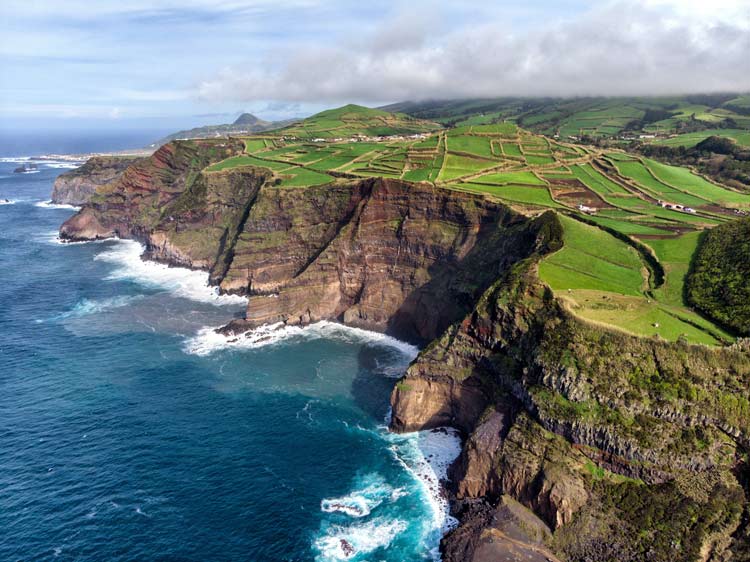
Azores Coast
“The vigia radioed this morning to say he saw some fins. We’ll head there first, make a little tour, and see if we can find ourselves some whales.” I look up from the nautical map and smile at Chris Beer, the red-bearded cheery captain of the Physeter.
The vessel is a whale-watching and scientific two-hull catamaran, and for part of the year, Chris and his wife Lisa lead scientific expeditions into the Azorean waters.
The Azores, about 1600 km (992 miles) off Portugal’s coast, are basalt tips rising thousands of meters off the mid-Atlantic ridge. This archipelago includes nine major islands and eight small islets.
Smack in the middle of a Northbound Gulf Stream, the waters churn around the islands with incredible biodiversity. Travel in the Azores often includes time exploring the sea.
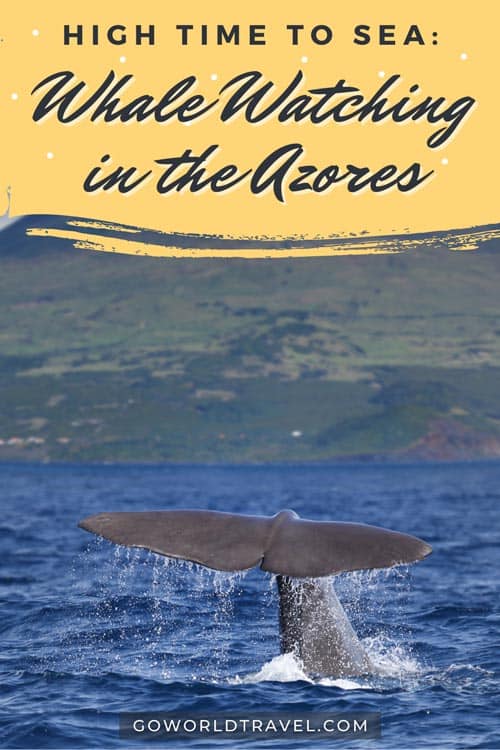
Turtles, sharks, countless fish and sea mammals call the Azores home. Nearly 30 percent of the world’s known whales and dolphins, known as the cetaceans, have been spotted in the Azores, including blue whales, fin whales, false killer whales and a host of dolphins.
Chris and Lisa met nearly 20 years ago while gathering sperm whale data, and with the pace and poise that comes from running a hands-on eco-tourist service to volunteers from around the world, their lives are a hustle to survey the water mammals and provide unforgettable experiences.
Lisa explains that the vigia are the lookouts who scan the waves and help find whales. “They’re amazing,” yells Lisa, as the wind and rumble of the powerful catamaran engines pick up when we leave the harbor, “they can spot whale blows from nearly 25 miles (40 km) away, and they can also tell us what species they are!”
As the Physeter pitches in the waves, Chris yells down from his steering vantage point, “Risso’s!”
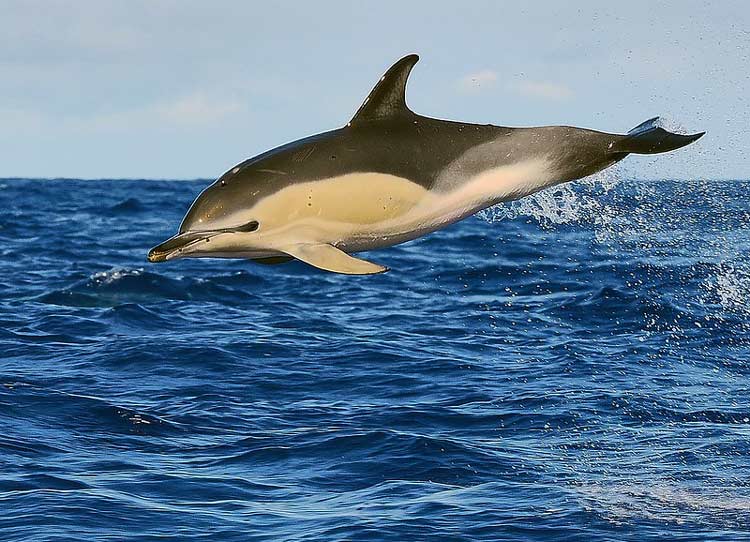
Dolphin Spotlight
All eyes jump to where he’s pointing, 30 meters (99 feet) off the port side of the boat. Although we’re barely out of the harbor, five of the gray-and-white marked dolphins cleave the waves up ahead.
Since Risso’s are less extroverted or abundant than the bottlenose or common dolphins, they haven’t quite made it into the dolphin spotlight.
With Chris expertly maneuvering the vessel so we’re never too close or intruding, Lisa and some of the volunteers make photo after photo of the quietly socializing animals. The Risso’s gray to white color also flashes turquoise when it hauntingly streams below the water surface. It’s an incredible sight that can’t easily be mistaken or forgotten.
“Wait ‘til you see a blue whale,” says Lisa, snapping photos all the while. “When they shallow dive, they can skim at 15 knots or more below the surface, and you can see a streaking light blue shadow go by, longer than the boat.”
The blue whale is said to be the largest animal that has ever lived—surpassing even the dinosaurs in terms of size and appetite—has haunted sailors, whalers, and now eco-tourists like no animal before it.
That this one animal can reach lengths longer than the 30-meter (99 feet) catamaran is hard to imagine. After half an hour, Lisa gives Chris a thumbs-up and he points us back towards where the whales were seen by the vigia.
In addition to Chris and Lisa, the Physeter can hold up to 12 more guests. With this many people, the pair have maximized the carrying capacity for both quality cetacean spotting and research.
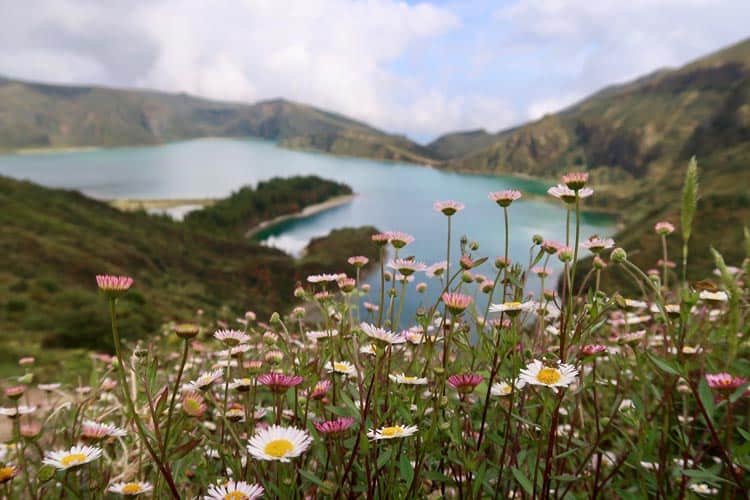
Biosphere Expeditions
For part of the year, thanks to an organization called Biosphere Expeditions, the pair welcome and employ a near-continuous stream of eco-tourists for hands-on research. Everyone pitches in recording position, sea state, water temperature and other variables, as well as monitoring the hydrophone and helping with photo-ID.
For the rest of the year, the couple takes visitors out on whale-watching tours. Given the biodiversity and animal traffic, whale and dolphin lovers find the Azores are a treat like nowhere else on the planet.
“BLOW!” yells out one of the Biosphere people from her starboard lookout. “Fin whales and a sei, 2 o’clock!”
Sure enough, we soon see three clustered blows some 500 yards (455 meters) away. Chris immediately aims the nose of the boat in their direction, and we beeline through the Atlantic chop. Chris yells down that we’re also entering a massive bloom of krill, thumb-sized shrimp-like crustaceans that some whales eat.
The waters are teeming with krill and the thousands of mackerel that dart through the swarms in a feeding-frenzy of silver and green.
Suddenly, all hands are raised in excitement as the massive maw of a whale breaks through the surface of the water, swallowing hundreds of gallons of seawater and krill.
Again and again, for over an hour, the whales surge and lunge from below, gulping the most incredible mass of water and food.
The jaws close, distending the enormous folds of skin beneath the lower jaw, and the whales push out the water with their tongues. Filtering the krill and small fish off the baleen, (their specialized teeth are composed of keratin, the same substance as hair), the whale’s tongue pushes out the water and swallow the tons of krill.
Within an hour, what used to be a massive swarm of shrimp-like animals is reduced to nothing. Wiped clean, the waves and whitecaps are a deep blue.
“Now we take today’s fluke-photographs,” says Lisa from the small office at the eco-lodge, “and we’ll see if the sperm whales were a resighting or new to the area.”
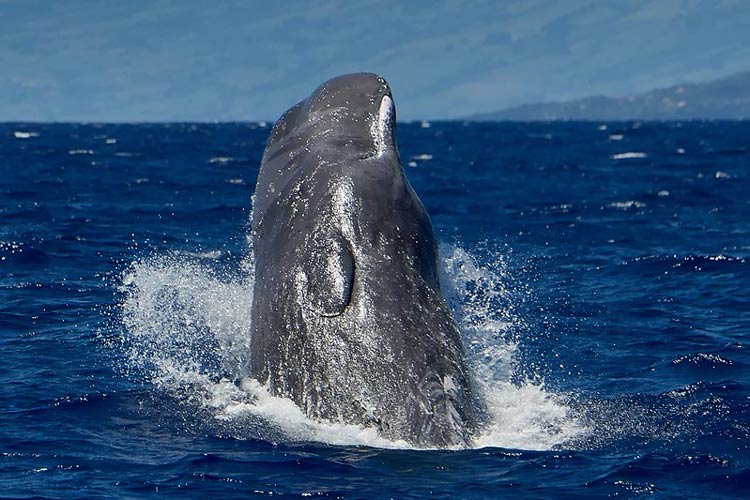
Azores Sperm Whales
The day was productive. After the Risso’s encounter and the fin and sei whale feeding, we discovered a pod of sperm whales heading through the Faial-Pico channel. An hour later, we found a 150-strong member group of bottlenose dolphins.
This was the first time Lisa had ever seen sperm whales in the channel, so she’s curious to see if these were already in the database.
Each sperm whale has a different-looking fluke. As the tissue gets worn away or damaged, the fluke profiles are great for photo-identification. Spermies, as they are affectionately known, will typically stay at the surface, inhaling and exhaling at 12-second intervals, and after 10 minutes, they’ll point their heads and deep for up to 50 minutes.
As they dive, the fluke clears the surface, giving researchers a quarter-second to photograph the tail. Before long, all the data and matching have been entered, heralded by Chris inviting one and all to Peter’s, a long-established local pub, for a celebratory round. This was a great day, and he wants to celebrate with his new friends.
Walking together down the cobblestone streets, we’re ushered forward by a gentle breeze on our backs. We look past the harbor and cliffs, scanning the open ocean. As countless ocean lovers have been before us, we are humbled by what we have experienced today.
If You Go
- Whale Watch Azores
- www.whalewatchazores.com
- Biosphere Expeditions
- www.biosphere-expeditions.org
Author’s Bio: An entrepreneur, artist, designer and business consultant, Ran Elfassy believes in making a positive difference for people around the world. He’s been published in Canada, the US, the UK and Hong Kong, and his recently released Book, Greening My Life – How to Help the Environment and Save Money While Doing It(www.greeningmylifeguide.com) is available now.
- Why the Kimberley Should Be Your Next Australian Adventure - July 5, 2025
- How We Finally Afforded Our Dream Trip to the Swiss Alps (And You Can Too) - July 5, 2025
- Escape Manhattan for Governors Island - July 5, 2025

